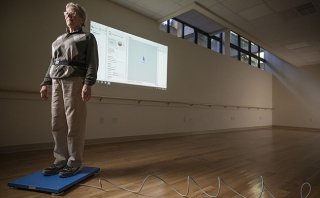Study Investigates Vascular Dysfunction as Mechanism Underlying Link Between Heart and Bone Health in Older Adults
Data collected from the Framingham Heart Study
-

Elizabeth (Lisa) Samelson, Ph.D.
Associate Scientist
Osteoporosis and cardiovascular disease tend to co-occur in older adults. A new study published in the Journal of Bone and Mineral Research measured vascular dysfunction in relation to bone loss and deterioration in bone microarchitecture to investigate whether this is due to shared risk factors or if there is a causal pathway by which vascular dysfunction with aging leads to skeletal fragility.
Researchers used data collected from 1,391 participants in the Framingham Heart Study to evaluate the link between blood vessel function and bone health. They used special tools to assess bone density and microstructure by measuring blood flow and pressure and advanced imaging called high-resolution peripheral quantitative computed tomography (HR-pQCT).
Entitled “Vascular function and skeletal fragility: A study of tonometry, brachial hemodynamics, and bone microarchitecture,” the study found that while people with impaired blood vessel function tend to have lower bone density and worse deterioration in bone micro-structure, the association did not remain after statistically controlling for age, sex, and other confounders. Although cardiovascular disease frequently co-occurs with osteoporosis, Ilana Usiskin, MD, lead author and clinical fellow at Brigham and Women’s Hospital, explained that “the results indicate that vascular function may not independently predict skeletal fragility independently of shared risk factors.”
Elizabeth (Lisa) Samelson, PhD, principal investigator for the NIH-funded study, associate scientist at Hebrew SeniorLife‘s Hinda and Arthur Marcus Institute for Aging Research, and associate professor at Harvard Medical School, added, “Cardiovascular disease and osteoporosis are highly prevalent conditions in older adults and responsible for significant morbidity and mortality. Our goal was to better understand whether or not vascular dysfunction plays a role in the development of osteoporosis, as early recognition of risk factors can lead to intervention and fracture prevention.”
The Framingham Heart Study, Boston University, Beth Israel Deaconess Medical Center, and the Marcus Institute at Hebrew SeniorLife collaborated on this study.
This study was supported by R01 AG065299, R01 AR061445, National Heart, Lung, and Blood Institute (NHLBI) contracts N01‐HC‐25195, HHSN268201500001I, and 75N92019D00031 and by DK080739, HL107385, HL126136‐01A1, HL93328, HL142983, HL143227, HL131532, HL70100, HL092577, 2U54HL120163, and AG066010.
Co-authors of the study include: Ilana M. Usiskin, MD, Division of Rheumatology, Inflammation, and Immunity at Brigham and Women’s Hospital; Gary F. Mitchell, MD, president of Cardiovascular Engineering Inc.; Mary L. Bouxsein, PhD., professor of orthopedic surgery at Beth Israel Deaconess Medical Center and Harvard Medical School; Ching-Ti Liu, PhD, professor of biostatistics at the Department of Biostatistics of Boston University School of Public Health; Douglas P. Kiel, MD, MPH, director of the Musculoskeletal Research Center and senior scientist at the Marcus Institute at Hebrew SeniorLife; and Elizabeth J. Samelson, PhD.
About Hebrew SeniorLife
Hebrew SeniorLife, an affiliate of Harvard Medical School, is a national senior services leader uniquely dedicated to rethinking, researching, and redefining the possibilities of aging. Hebrew SeniorLife cares for more than 4,500 seniors a day across campuses throughout Greater Boston. Locations include: Hebrew Rehabilitation Center-Boston and Hebrew Rehabilitation Center-NewBridge in Dedham; NewBridge on the Charles, Dedham; Orchard Cove, Canton; Simon C. Fireman Community, Randolph; Center Communities of Brookline, Brookline; Jack Satter House, Revere; and Leyland Community, Dorchester. Founded in 1903, Hebrew SeniorLife also conducts influential research into aging at the Hinda and Arthur Marcus Institute for Aging Research, which has a portfolio of more than $98 million, making it one of the largest gerontological research facilities in the U.S. in a clinical setting. It also trains more than 500 geriatric care providers each year. For more information about Hebrew SeniorLife, visit our website or follow us on our blog, Facebook, Instagram, Threads, and LinkedIn.


